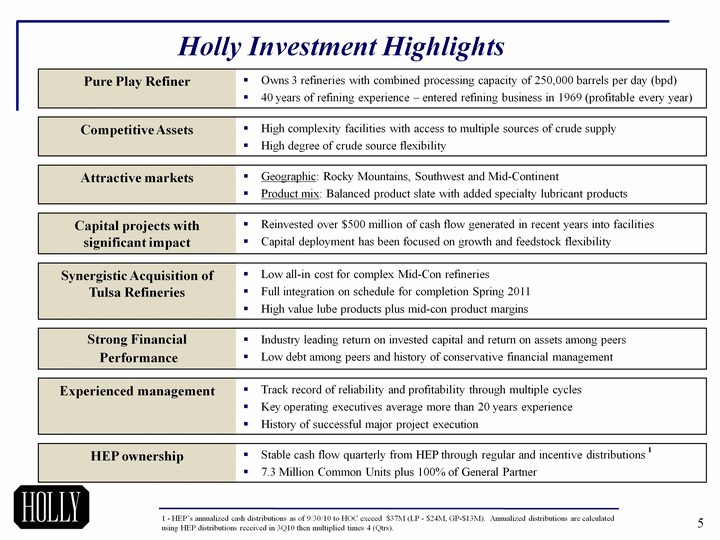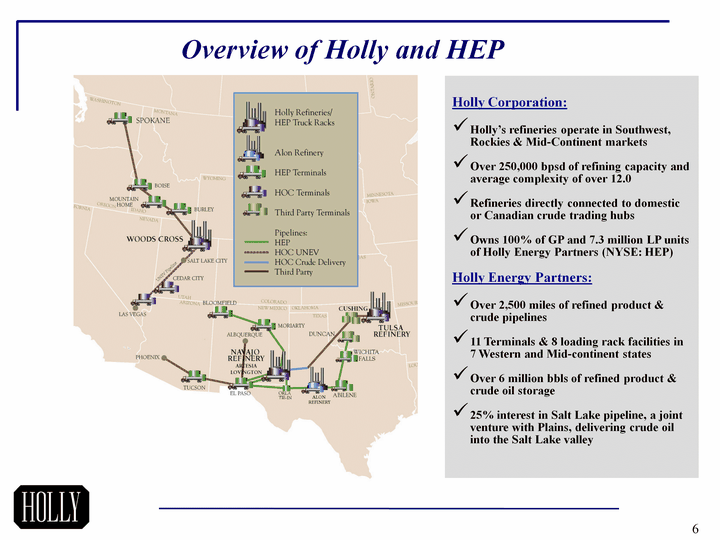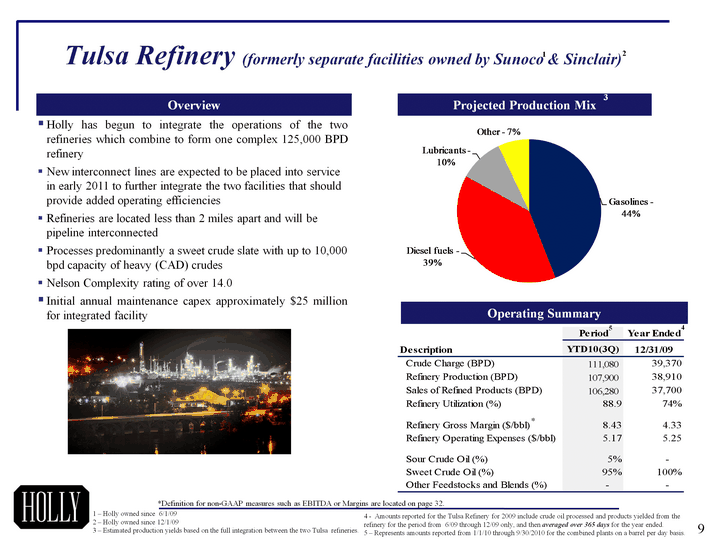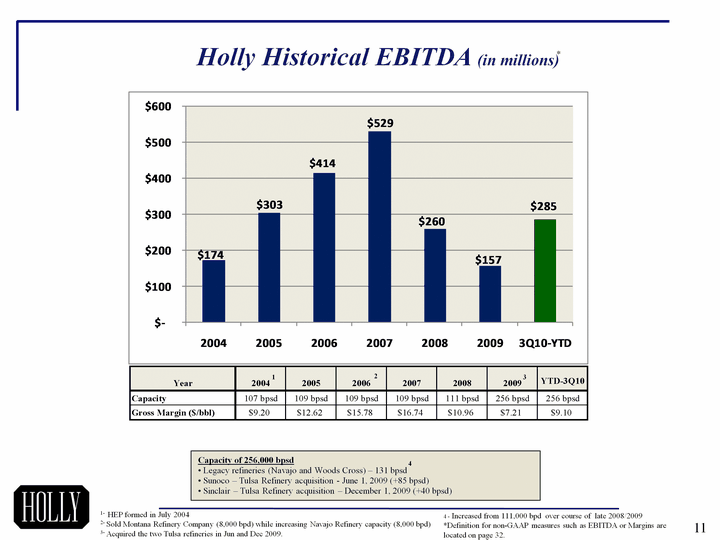Attached files
| file | filename |
|---|---|
| 8-K - FORM 8-K - HollyFrontier Corp | c10649e8vk.htm |
Exhibit 99.1

| Holly CorporationWinter 2010 |

| 2 |

| 3 Holly Corporation Disclosure Statement Statements made during the course of this presentation that are not historical facts are "forward-looking statements" within the meaning of the U.S. Private Securities Litigation Reform Act of 1995. Forward- looking statements are inherently uncertain and necessarily involve risks that may affect the business prospects and performance of Holly Corporation and/or Holly Energy Partners, L.P., and actual results may differ materially from those discussed during the presentation. Such risks and uncertainties include but are not limited to risks and uncertainties with respect to the actions of actual or potential competitive suppliers and transporters of refined petroleum products in Holly's and Holly Energy Partners' markets, the demand for and supply of crude oil and refined products, the spread between market prices for refined products and market prices for crude oil, the possibility of constraints on the transportation of refined products, the possibility of inefficiencies or shutdowns in refinery operations or pipelines, effects of governmental regulations and policies, the availability and cost of financing to Holly and Holly Energy Partners, the effectiveness of Holly's and Holly Energy Partners' capital investments and marketing and acquisition strategies, the possibility of terrorist attacks and the consequences of any such attacks, and general economic conditions. Additional information on risks and uncertainties that could affect the business prospects and performance of Holly and Holly Energy Partners is provided in the most recent reports of Holly and Holly Energy Partners filed with the Securities and Exchange Commission. All forward-looking statements included in this presentation are expressly qualified in their entirety by the foregoing cautionary statements. Holly and Holly Energy Partners undertake no obligation to publicly update or revise any forward-looking statements, whether as a result of new information, future events or otherwise. |

| 4 Presentation Topics HOC Company OverviewFinancial Performance and CompetitivenessFocused Growth OrientationSummaryAppendix |

| 5 Holly Investment Highlights Holly Investment Highlights 1 - HEP's annualized cash distributions as of 9/30/10 to HOC exceed $37M (LP - $24M, GP-$13M). Annualized distributions are calculated using HEP distributions received in 3Q10 then multiplied times 4 (Qtrs). 1 |

| 6 Overview of Holly and HEP Holly Corporation:Holly's refineries operate in Southwest, Rockies & Mid-Continent marketsOver 250,000 bpsd of refining capacity and average complexity of over 12.0Refineries directly connected to domestic or Canadian crude trading hubsOwns 100% of GP and 7.3 million LP units of Holly Energy Partners (NYSE: HEP)Holly Energy Partners:Over 2,500 miles of refined product & crude pipelines11 Terminals & 8 loading rack facilities in 7 Western and Mid-continent statesOver 6 million bbls of refined product & crude oil storage25% interest in Salt Lake pipeline, a joint venture with Plains, delivering crude oil into the Salt Lake valley |

| 7 Navajo Refinery Product Sales Mix (12/31/09) Overview 561 acre site located in Artesia, NM with crude capacity of 100,000 BPSD (expanded in Q1 2009)Ability to process sour and heavy (Canadian) crude oils into high value light products Distributes to high margin markets in Arizona, New Mexico and West TexasNelson Complexity rating of 11.8Last turnaround completed in Q1 2009. Annual maintenance capex approximately $10 million Operating Summary *Definition for non-GAAP measures such as EBITDA or Margins are located on page 32. * |

| 8 Woods Cross Refinery Product Sales Mix (12/31/09) Overview 200 acre site located in Woods Cross, UT (near Salt Lake City) with crude oil capacity of 31,000 BPDProcesses regional sweet and lower cost black wax crude as well as Canadian sour crude oils Distributes to high margin markets in Utah, Idaho, Nevada, Wyoming, and eastern WashingtonNelson Complexity rating of 12.5 Last turnaround completed in Q3 2008. Annual maintenance capex approximately $5 million Operating Summary (CHART) * *Definition for non-GAAP measures such as EBITDA or Margins are located on page 32. |

| 9 Tulsa Refinery (formerly separate facilities owned by Sunoco & Sinclair) Projected Production Mix Overview Holly has begun to integrate the operations of the two refineries which combine to form one complex 125,000 BPD refineryNew interconnect lines are expected to be placed into service in early 2011 to further integrate the two facilities that should provide added operating efficienciesRefineries are located less than 2 miles apart and will be pipeline interconnectedProcesses predominantly a sweet crude slate with up to 10,000 bpd capacity of heavy (CAD) crudesNelson Complexity rating of over 14.0Initial annual maintenance capex approximately $25 million for integrated facility 1 2 3 Operating Summary * 4 1 - Holly owned since 6/1/09 2 - Holly owned since 12/1/093 - Estimated production yields based on the full integration between the two Tulsa refineries. 4 - Amounts reported for the Tulsa Refinery for 2009 include crude oil processed and products yielded from the refinery for the period from 6/09 through 12/09 only, and then averaged over 365 days for the year ended.5 - Represents amounts reported from 1/1/10 through 9/30/2010 for the combined plants on a barrel per day basis. *Definition for non-GAAP measures such as EBITDA or Margins are located on page 32. 5 |

| 10 Presentation Topics HOC Company OverviewFinancial Performance and CompetitivenessFocused Growth OrientationSummaryAppendix |

| 11 Holly Historical EBITDA (in millions) Capacity of 256,000 bpsd Legacy refineries (Navajo and Woods Cross) - 131 bpsd Sunoco - Tulsa Refinery acquisition - June 1, 2009 (+85 bpsd) Sinclair - Tulsa Refinery acquisition - December 1, 2009 (+40 bpsd) 4 - Increased from 111,000 bpd over course of late 2008/2009*Definition for non-GAAP measures such as EBITDA or Margins are located on page 32. 1- HEP formed in July 20042- Sold Montana Refinery Company (8,000 bpd) while increasing Navajo Refinery capacity (8,000 bpd)3- Acquired the two Tulsa refineries in Jun and Dec 2009. 1 2 3 * 4 |

| 12 Historical Refining Margins 1 - Actual realized gross margin.2 - PADD II 3-2-1 gross margin proxy for Tulsa refineries Tulsa Gulf Coast 3-2-1: 5 Yr. Avg. 2 *Definition for non-GAAP measures such as EBITDA or Margins are located on page 32. Navajo Gulf Coast 3-2-1: 5 Yr. Avg. 1 Woods Cross 1 Gulf Coast 3-2-1: 5 Yr. Avg. * 5-yr. high & low gross margin range by quarter - tan bars 2009 Gross Margin ($/bbl) - noted in black numeric 5 Yr. Quarterly Average Gross Margin ($/bbl ) - Navajo, Woods Cross - blue line Gulf Coast 5-Yr. Quarterly Avg 3-2-1 margin- green line 5 Yr. Quarterly Average Gross Margin ($/bbl ) - PADD II - red line |

| Gasoline & Diesel Cracks 13 1 - Gasoline and Diesel cracks are determined using NYMEX product and crude oil (WTI) postings for each respective period and market. These are not HOC specific cracks and are intended to display general market trends with respect to both gasoline and diesel.2 - US Energy Information Administration provided estimates. GasolineHOC markets have consistently outperformed Gulf Coast Gasoline cracks2010 YTD US demand has been relatively flat (up .3% from 2009)Gasoline cracks improved in almost all markets in both 2010 and 2009 after reaching low recessionary levels in 2008 Diesel HOC markets have consistently outperformed Gulf Coast Diesel cracks2010YTD demand is up 4% from the same period in 20092009 US Diesel demand was down over 12% vs. 2008 levels. Diesel crack weakness was more pronounced in 2009 than in 2008 while rebounding in 2010 1 2 2 2 |

| Conservative Balance Sheet and Strong Returns on Capital 14 1 - Debt levels exclude Sunoco Logistics (SLX) Debt2 - HOC debt excludes HEP Debt ($489M @ 9/30/2010, which is non recourse to HOC). Supporting calculations /details are located on page 31-32. Supporting calculations /details are located on page 31-32. Supporting calculations /details are located on page 31-32. Supporting calculations /details are located on page 31-32. Net debt to total cap of 10% @ 9/30/10 ($272M cash) Highest ROIC among peers 3 3 1 2 4 4 * 3 - HOC Cash @ 9/30/2010. See page 15 for details.4 - This table provides the calculated debt to total capitalization (%). Supporting calculation/details are provided on slides 31-32. *Definition and calculations for measures such as Debt / Capital, Net Debt to total Capitalization and ROIC can be located on page 32. |

| Past investments make legacy refineries stronger 15 Capital Expenditure Overview 1. Excludes HEP capex; net of contributions from UNEV JV partner; includes turnaround expenditures; excludes asset acquisitions2. As of 9/30/10; excludes HEP capex and cash. Strong balance sheet and liquidity going forward 1 Cash balance: $272M (excludes HEP cash)$400 mm credit facility $300 mm of Holly senior unsecured notes2010 Capex Estimate - $165mm$105mm - Refining (including maintenance, capex and turnarounds) $60mm - UNEVYTD Capex through 3Q10 - $114MAdditional proceeds expected from UNEV interest sale of over $220 mm expected in 20117.3M common units of HEP and 100% GP ownership 2 |

| 16 Presentation Topics HOC Company OverviewFinancial Performance and CompetitivenessFocused Growth OrientationSummaryAppendix |

| HOC Growth - Thru Strategic Investments & Acquisitions Approx $500mm invested for enhanced feedstock flexibility and modest growthSynergistic acquisitions of Tulsa refineries at less than $1,000 per daily bbl*Uniquely positioned among peers to enter up-cycle at more than 2008 capacity 17 *After accounting for sales of Tulsa logistics assets, see slide 19 for more details. Tulsa East & West HOC: Navajo & Woods Cross Refinery Capacity |

| 18 Enhanced Competitive Position at Legacy Refineries Recently Completed Refinery Enhancements Increased capacity 19%Increased lower cost black wax and Canadian crude processing from 20 to 50%Increased ULSD production percentageEnhanced black wax and Canadian heavy receiving capabilities Increased capacity 17% (to 100,000 bpd)Allows 100% sour crude oil processingIncreased ULSD production percentageIncreased intermediates processingProvides access to Cushing crude oil hub and a variety of cost advantaged crudes Enables refinery to shift up to 40% of its crude slate to lower priced heavy crudes * * Crude unit work is mechanically complete. Navajo began processing a small amount (4,000 - 5,000 bpd) of Canadian crude in summer 2010 and plans to increase this rate as refining economics and crude differentials dictate. |

| 19 Holly is in process of further integrating the two Tulsa facilities to form one complex 125,000 BPD refineryConstructing interconnect pipelines that will transfer various intermediate streams between facilities and optimize blending, increase yields and reduce operating expensesRefinery integration results in net capex savings of approximately $125 million that would have otherwise been required for the Sunoco refinery:Eliminates an estimated $110 million of project capital requirementsReduces MSAT 2 compliance capex by about $15 millionDiesel Hydrotreater expansion ($20M) at East facility to satisfy ULSD requirements anticipated to be completed by the end of 1Q 2011 Strategic Acquisitions at Historically Low Multiples 1 - Full integration could take up to 18 months but gas oil upgrade is available immediately.2 - Purchase price does not include inventory.3 - Includes $89 million Tulsa portion of the $93 million dropdown transaction completed on 3/31/10. $2,000 $1,186 $ / Complexity BBL $18,000 $11,325 $ / BBL of capacity High Average Refinery industry acquisitions over the last five years: 2 3 1 |

| 20 UNEV Pipeline & Refinery Economics Overview: 400 mile, 12" refined products pipeline from Salt Lake City to Las Vegas with terminals in Cedar City, UT and Las Vegas, NVHolly owns 75% interest (Sinclair 25%)Completion Date - Spring/Summer 2011Benefits:Las Vegas gasoline trades at premium to Salt Lake Lowers impact of Salt Lake City seasonal demand reductionProvides access to growth market for Rocky Mountain refinersHEP Purchase Option:At completion of construction, HEP will have option to purchase HOC's interest in the pipeline JV for 180 days from completion of project at HOC's cost (estimated to be $225 mm) plus a 7% per annum carrying cost |

| 21 Presentation Topics HOC Company OverviewFinancial Performance and CompetitivenessFocused Growth OrientationSummaryAppendix |

| 22 Summary Holly Corporation:Competitive refining assets in attractive marketsRecent investments to make legacy refineries even strongerLow entry cost for very complex Tulsa refining facility (Sunoco + Sinclair)Conservative capital structure plus experienced management teamHEP ownership ($375mm plus GP value)Holly Energy Partners:100% fee-based business Long-term contracts support minimum commitmentsHistory of steady EBITDA/DCF growthNo commodity ownership risk 1 1 - HOC's owns approximately 7.3M limited partner units of HEP (NYSE) . |

| 23 Holly Corporation (NYSE: HOC)100 Crescent Court, Suite 1600Dallas, Texas 75201(214) 871-3555Neale Hickerson, Vice President, Investor RelationsNeale.hickerson@hollycorp.com214-871-3555www.hollycorp.com |

| 24 Presentation Topics HOC Company OverviewFinancial Performance and CompetitivenessFocused Growth OrientationSummaryAppendix |

| 25 Appendix Tulsa - Sunoco Refinery Acquisition Tulsa - Sinclair Refinery Acquisition Estimated Effects of Capital Projects Balance Sheet Highlights Financial metrics Definitions |

| 26 Tulsa (Sunoco) Acquisition - Transaction Summary Asset Summary: Tulsa (West) refinery has crude capacity of 85,000 BPSDHigh complexity: 11.4 Nelson complexity factorProduces high value specialty products and transportation fuelsStrategic location - direct pipeline connection to Cushing crude oil hub and Magellan product system that supplies the Mid-Continent market Assets include 3.2 million bbls of storage & related logistic assetsAssignment of the Sunoco specialty product trademark for N. America and license for S. AmericaPurchase Summary:$65 million in cash to purchase refinery property, plant and equipmentInventory purchased at closing market pricesClosed: June 1, 2009Off-take Agreement: Five year off-take agreement for gas oil to SunocoEnvironmental Indemnification: Sunoco would retain responsibility for certain environmental liabilities for 20 years resulting from operations of the refinery prior to closingEPA Waiver: EPA waiver granted which extends the existing ULSD compliance deadline to November 2011 |

| 27 Sinclair Refinery - Transaction Summary Holly purchased Sinclair's Tulsa refinery December 1, 2009Holly's portion of the purchase price consisted of $74.0 million in Holly stock (2.8M shares @ $26.53) and $54.5 million of cash at closing (for total of $128.5)At closing Sinclair entered into a long-term off take agreement for up to 50,000 BPD of gasoline/diesel to supply their Mid-Con branded and unbranded marketing networkHolly has entered into a contract for storage and logistics services with HEP relating to the assets that HEP purchased from Sinclair Sinclair's Tulsa refinery is a 75,000 barrel per stream day ("bpsd") cracking refinery located approximately 2 miles southeast of Holly's Tulsa West facility(1)Holly purchased approximately 500,000 barrels of inventory from Sinclair at closing 1 Combined fully integrated capacity of Holly's existing Tulsa refinery and Sinclair's refinery is projected to be approximately 125,000 bpsd |

| Estimated Effects of Capital Projects at Holly's Legacy RefineriesIllustrative computations of impact of expansion & gross margins 28 Gross Margin/bbl Consolidated Navajo Woods Cross 2003 $7.23 $7.43 $6.10 2004 $9.20 $10.16 $6.00 2005 $12.62 $13.61 $9.62 2006 $15.78 $15.37 $17.10 2007 $16.74 $15.58 $20.69 2008 $10.96 $9.55 $16.60 2009 $7.21 $7.20 $11.27 For every +/- $1/bbl change in gross margin: NRC equals $5.475 million -- WX equals $1.825 million INCREMENTAL GROSS MARGIN FROM REFINERY EXPANSIONS: Wood Cross completion Q3 '08 -- Operational Q4 '08 / Navajo completion Q1 '09 -- Operational Q2 '09 (in $millions) Margin/ bbl assumption: $6.00 $8.00 $10.00 $12.00 $14.00 NRC: at 15,000 bpsd expansion $33 $44 $55 $66 $77 WX: at 5,000 bpsd expansion $11 $15 $18 $22 $26 |

| 29 Estimated Effects of Capital Projects at Holly's Legacy RefineriesIllustrative computations of impact of crude mix changes Every +/- $1 change in net feedstock costs equals $3.65 million Every +/- $1 change in net feedstock costs equals $14.6 million All dollar values are for a full year impact and assume operating rates are at full utilization with no operating downtime FEEDSTOCK FLEXIBILITY: WOODS CROSS REFINERY Completion Q3 '08 -- Operational Q4 '08 (in $ millions) Increase cost advantaged bbls by 10,000 bpsd WTI-Heavy Diff. / bbl assumption: (net of transportation & yield changes) $5.00 $10.00 $15.00 $20.00 Annual gross margin improvement from feedstock flexibility $18 $36 $54 $73 FEEDSTOCK FLEXIBILITY: NAVAJO REFINERY Completion Q3 '09 -- Operational Q1 '10 (in $ millions) Change crude charge mix from 100% WTS crude to include 40% cost-advantaged bbls WTS-Heavy Diff. / bbl assumption: (net of transportation & yield changes) $5.00 $10.00 $15.00 $20.00 Annual gross margin improvement from feedstock flexibility $73 $146 $219 $292 |

| Holly (stand alone) $millions Cash $272 Senior notes $300 Revolver capacity $400 Balance - Credit Ratings BB Ba3 Balance Sheet / Liquidity 30 Balance Sheet Highlights and Liquidity Other:HEP has an option to purchase HOC's interest in the UNEV 180 days from completion of project at HOC's cost (estimated to be $225mm) plus a 7% per annum carrying costHOC expects proceeds from UNEV interest sale of over $220 mm in summer 2011. 1 - Excludes $480M of HEP debt that is nonrecourse to HOC.2 - As of 9/30/2010 1 2 |

| Financial metrics 31 **Amounts from Frontier Oil Corp, Sunoco Inc., Sunoco Inc. xSXL, Tesoro Corp and Valero Energy Corp are based on publicly- available financial statements of these issuers, which we have assumed to be accurate. |

| 32 Definitions Non GAPP measurements: We report certain financial measures that are not prescribed or authorized by U. S. generally accepted accounting principles ("GAAP"). We discuss management's reasons for reporting these non-GAAP measures below. Although management evaluates and presents these non-GAAP measures for the reasons described below, please be aware that these non-GAAP measures are not alternatives to revenue, operating income, income from continuing operations, net income, or any other comparable operating measure prescribed by GAAP. In addition, these non-GAAP financial measures may be calculated and/or presented differently than measures with the same or similar names that are reported by other companies, and as a result, the non-GAAP measures we report may not be comparable to those reported by others.Refining gross margin or refinery gross margin: the difference between average net sales price and average costs of products per barrel of produced refined products. This does not include the associated depreciation, depletion and amortization costs. Refining gross margin or refinery gross margin is a non-GAAP performance measure that is used by our management and others to compare our refining performance to that of other companies in our industry. This margin does not include the effect of depreciation, depletion and amortization. Other companies in our industry may not calculate this performance measure in the same manner. Our historical refining gross margin or refinery gross margin is reconciled to net income under "Reconciliation to Amounts Reported Under Generally Accepted Accounting Principles" of Holly Corporation's 2009 10-K filed February 26, 2010.Net Operating Margin: Net operating margin is a non-GAAP performance measure that is used by our management and others to compare our refining performance to that of other companies in our industry. This margin does not include the effect of depreciation, depletion and amortization. Other companies in our industry may not calculate this performance measure in the same manner. Our historical net operating margin is reconciled to net income under "Reconciliation to Amounts Reported Under Generally Accepted Accounting Principles" of Holly Corporation's 2009 10-K filed February 26, 2010.EBITDA: Earnings before interest, taxes, depreciation and amortization, which we refer to as EBITDA, is calculated as net income plus (i) interest expense net of interest income, (ii) income tax provision, and (iii) depreciation, depletion and amortization. EBITDA is not a calculation provided for under accounting principles generally accepted in the United States; however, the amounts included in the EBITDA calculation are derived from amounts included in our consolidated financial statements. EBITDA should not be considered as an alternative to net income or operating income as an indication of our operating performance or as an alternative to operating cash flow as a measure of liquidity. EBITDA is not necessarily comparable to similarly titled measures of other companies. EBITDA is presented here because it is a widely used financial indicator used by investors and analysts to measure performance. EBITDA is also used by our management for internal analysis and as a basis for financial covenants. Our historical EBITDA is reconciled to net income under "Reconciliation to Amounts Reported Under Generally Accepted Accounting Principles" of Holly Corporation's 2009 10- K filed February 26, 2010Debt-To-Capital: A measurement of a company's financial leverage, calculated as the company's long term debt divided by its total capital. Debt includes all long-term obligations. Total capital includes the company's debt and shareholders' equity. 5 Year Return on Invested Capital: A measurement which for our purposes is calculated using the 5 year average Net Income divided by the sum of the 5 year average of Total Equity and Long Term Debt. We consider ROIC to be a meaningful indicator of our financial performance, and we evaluate this metric because it measures how effectively we use the money invested in our operations.BPD: the number of barrels per calendar day of crude oil or petroleum products.BPSD: the number of barrels per stream day of crude oil or petroleum products.MMSCFD: million standard cubic feet per day.Gas Oil Hydrocracker: a refinery unit which uses catalyst at high pressure and temperature and in the presence of hydrogen to convert high boiling point hydrocarbons to light transportation fuels and low sulfur FCC feedstock.Solvent deasphalter / residuum oil supercritical extraction ("ROSE"): a refinery unit that uses a light hydrocarbon like propane or butane to extract non asphaltene heavy oils from asphalt or atmospheric reduced crude. These deasphalted oils are then further converted to gasoline and diesel in the FCC process. The remaining asphaltenes are either sold, blended to fuel oil or blended with other asphalt as a hardener.. |
